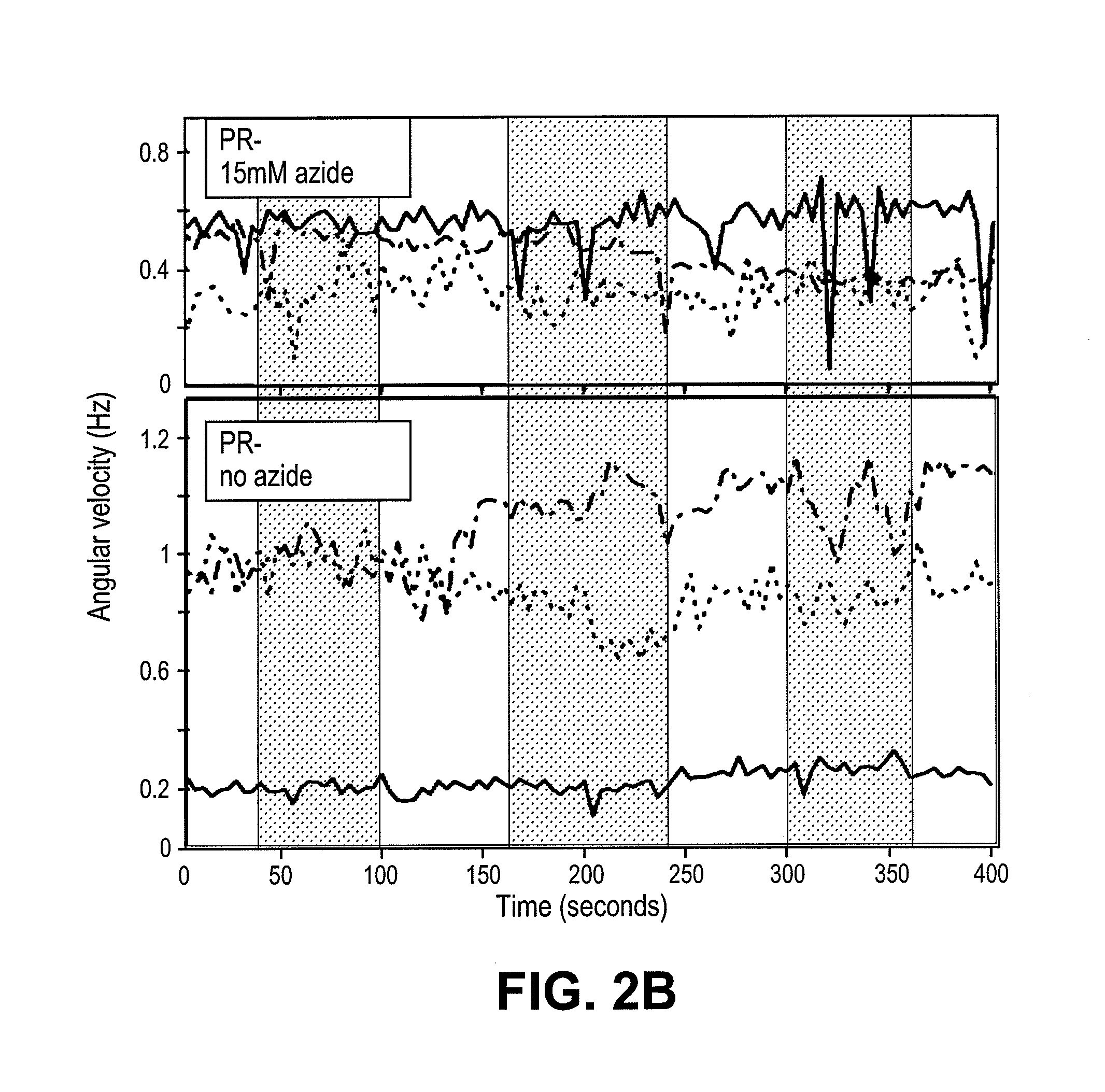Cells with non-natural physiologies derived by expressing light-powered proton pumps in one or more membranes
a proton pump and cell technology, applied in the field of bioenergy research, can solve the problems of insufficient cellular energy, inability to meet the input biomass, and limited biofuel production efficiency of a given microbe, and achieve the effects of enhancing the ability of a strain, and promoting protein dimerization or oligomerization
- Summary
- Abstract
- Description
- Claims
- Application Information
AI Technical Summary
Benefits of technology
Problems solved by technology
Method used
Image
Examples
example 1
[0096]Cell culture. We expressed the SAR86 γ-proteobacterial PR-variant (Geneart, Inc) in E. coli cells (RP437 DE3 ΔcheY CmR) using a T7 based expression system (pET200, KanR, Invitrogen). Cells were grown in T broth (1% Tryptone, 0.5% NaCl) supplemented with kanamycin (25 μg / ml). In mid-log phase, PR expression was induced with 1 mM IPTG and the medium was supplemented with 10 μM ethanolic all-trans-retinal. Cells were collected in late log phase by gentle centrifugation (4500×g, 5 min) and carefully resuspended in motility medium (1 mM PBS (Ambion), 0.1 mM EDTA, pH 7.4). PR+ denotes cells expressing proteorhodopsin, and PR− denotes cells (RP437 DE3 ΔcheY CmR) without the PR plasmid. PR− cells, unless otherwise noted, were also induced with IPTG, supplemented with all-trans-retinal and grown in T broth with chloramphenicol (25 μg / ml). Unless otherwise noted, all experiments were done in glucose free motility medium and at room temperature.
[0097]Instrumentation. Power density values...
example 2
[0105]FIG. 3C shows a highly simplified model of E. coli membrane fluxes. The PR+ cells described in this Example have multiple proton pumps that can contribute to the pmf (28), including PR, the respiratory chain, and the ATPase (FIG. 3C). Pmf is consumed by the flagellar motor and numerous transporters. In addition, the bacterial membrane has a basal permeability to protons (29). The model shown in FIG. 3D has been paramaterized by fitting it to the data shown in FIGS. 3A and 3B, and in FIG. 4. This model describes in vivo time-dependent dynamics between light-driven proton pumping and respiration. Despite the model's simplicity, it suggests why no effect of PR on growth rates has been reported. The model indicates that the maximum potential PR can generate using the free energy from photon absorption (VPR) is similar to the potential generated by E. coli respiration. Thus, according to this model, PR cannot pump protons in E. coli grown at neutral pH in rich or minimal media, or ...
example 3
[0106]In addition to powering the flagellar motor, this Example shows that PR can pump sufficient protons to increase cell viability. Cell cultures were plated following their exposure to 30 mM azide for 30 min in sunlight. The cells lacking retinal were most sensitive to azide. No colonies were recovered after plating the azide exposed cells. The cells lacking PR but having retinal were slightly more azide resistant (1% percent of cells survived; Table 1). The cells with both PR and retinal were significantly more azide resistant than in all three other conditions (11% of cells survived, p<0.005, Mann-Whitney U test). Thus, consistent with the motility studies and the pmf model, PR is able to sustain cellular pmf at a level that increases viability.
TABLE 1Effect of sunlight on cell viability following azide exposureNull hypothesis: the ability Percentage of cells survivingto pump protons does not Caseazide and light exposureincrease cell survivalPR+RET+3.4, 9.3, 2.2, 3.7, 4.6, 27, ...
PUM
| Property | Measurement | Unit |
|---|---|---|
| molecular weight | aaaaa | aaaaa |
| molecular weight | aaaaa | aaaaa |
| molecular weight | aaaaa | aaaaa |
Abstract
Description
Claims
Application Information
 Login to View More
Login to View More - R&D
- Intellectual Property
- Life Sciences
- Materials
- Tech Scout
- Unparalleled Data Quality
- Higher Quality Content
- 60% Fewer Hallucinations
Browse by: Latest US Patents, China's latest patents, Technical Efficacy Thesaurus, Application Domain, Technology Topic, Popular Technical Reports.
© 2025 PatSnap. All rights reserved.Legal|Privacy policy|Modern Slavery Act Transparency Statement|Sitemap|About US| Contact US: help@patsnap.com



